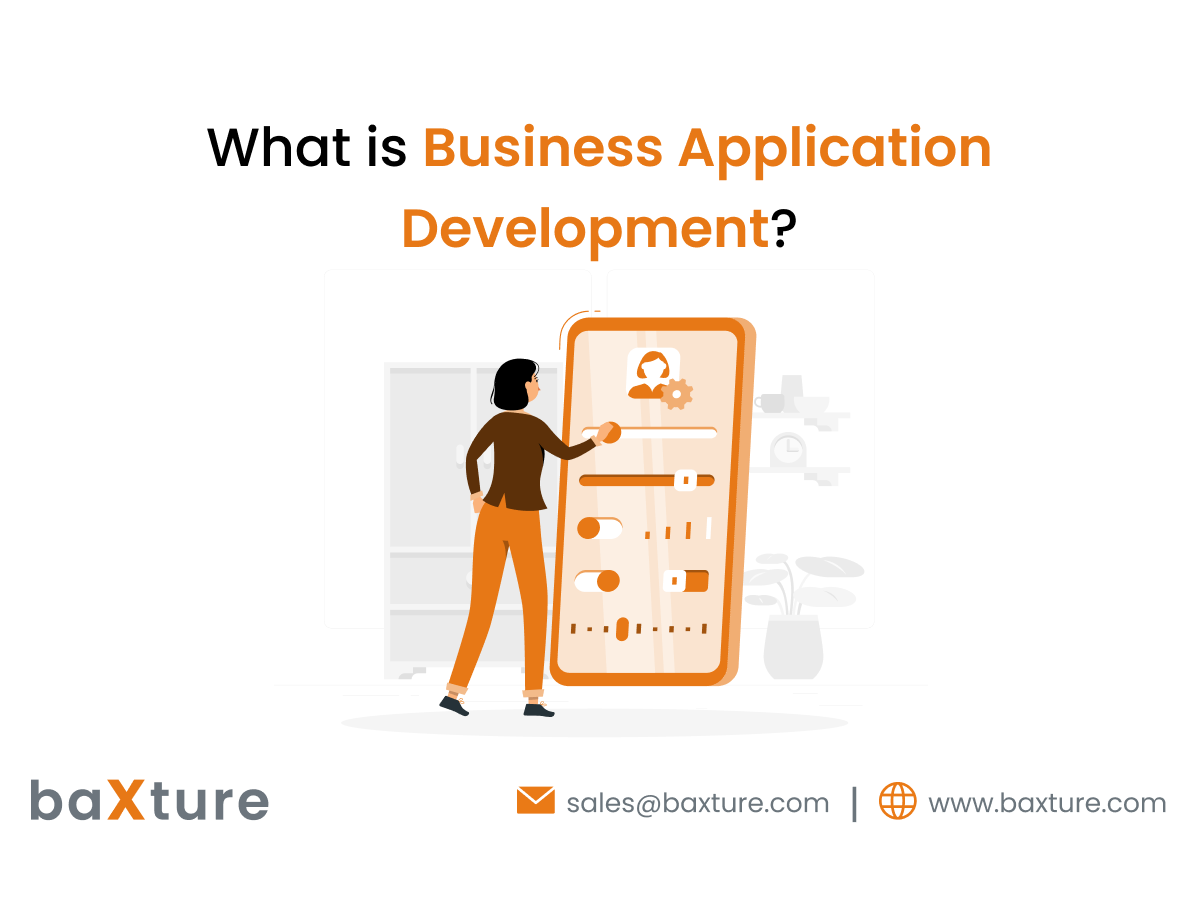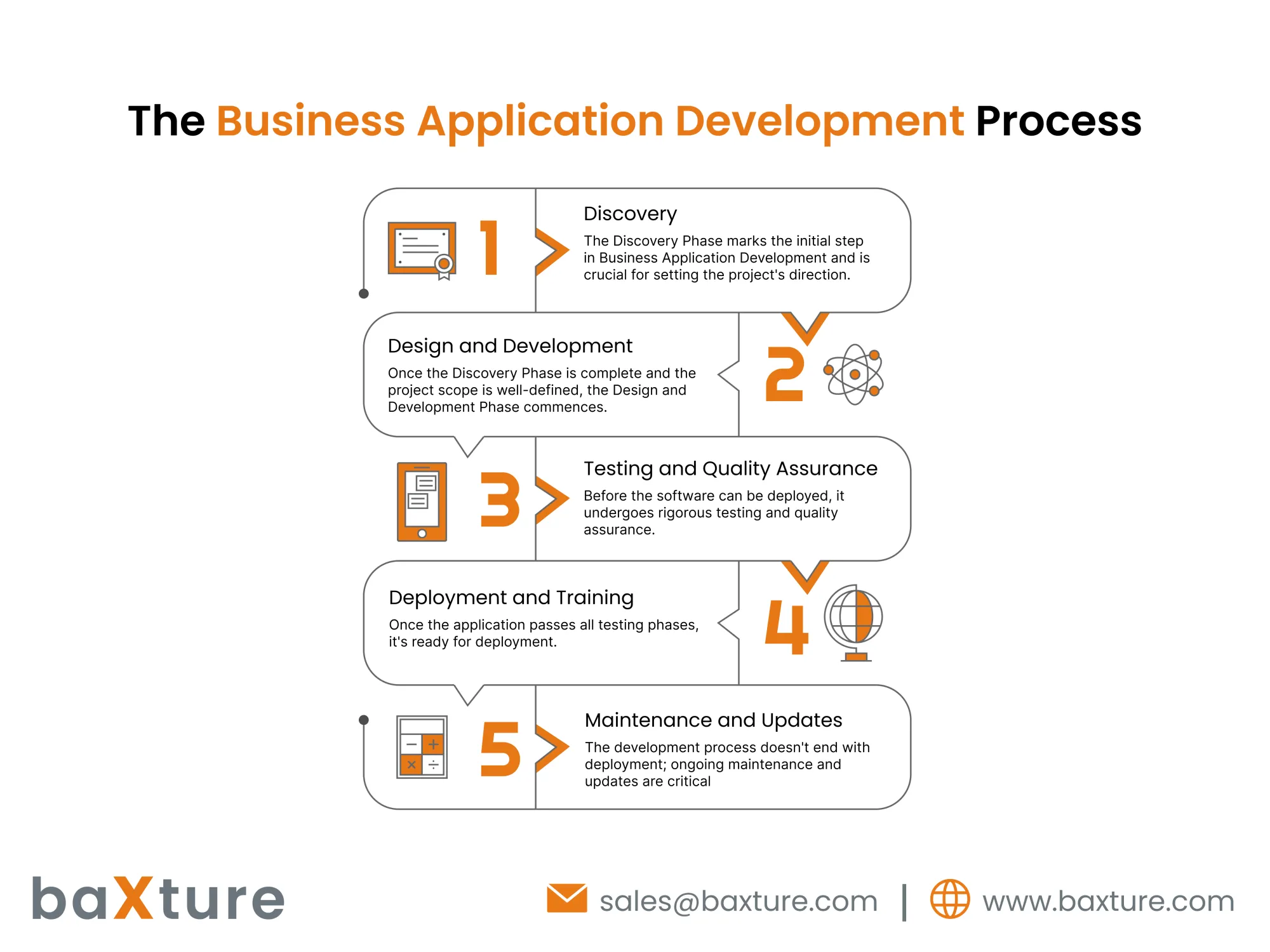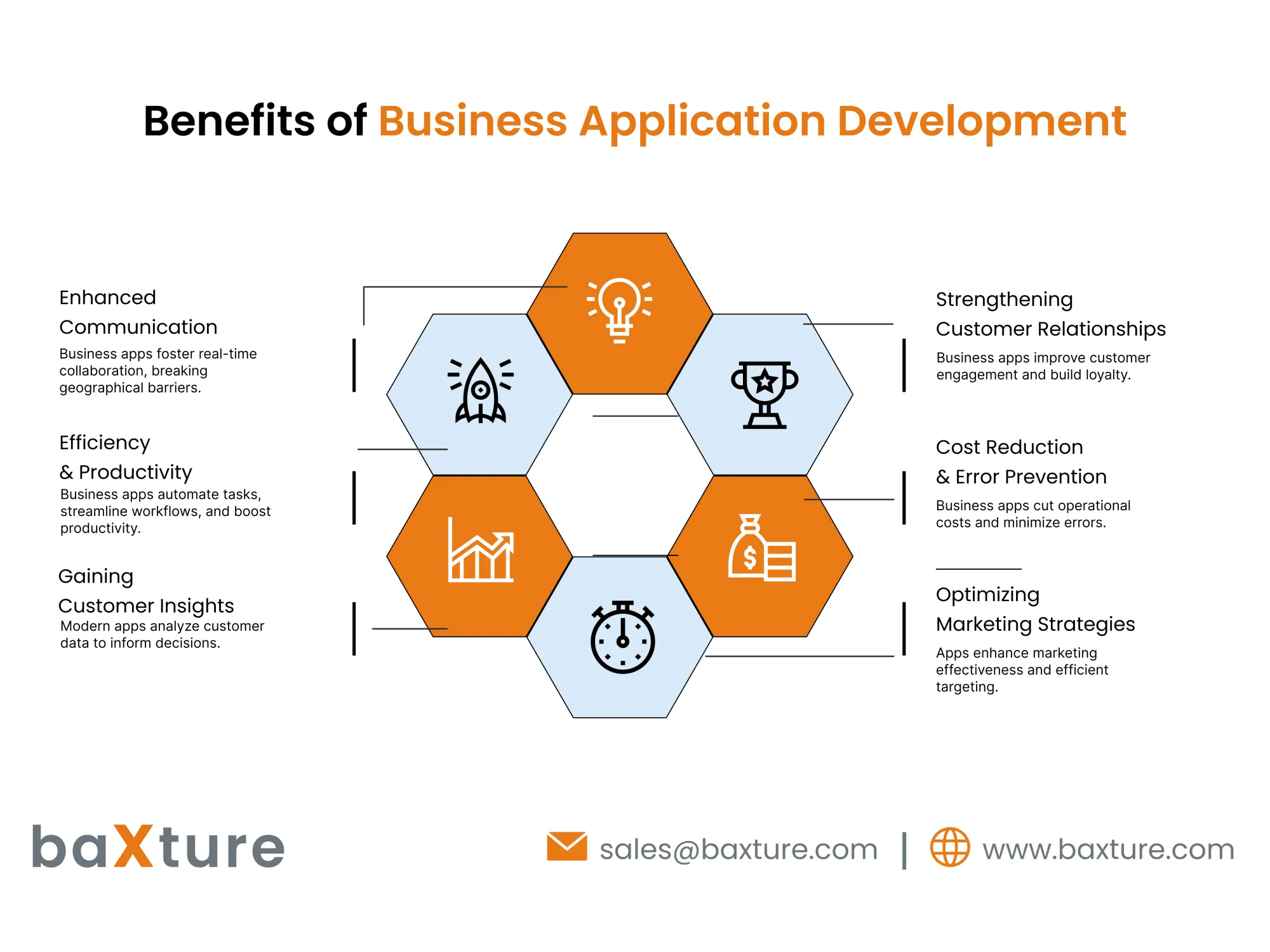Blogs
What is Business Application Development?

Business Application Development, often referred to simply as "App Development" or "Business Software Development," is the process of creating customized software solutions tailored to meet the specific needs and objectives of a business or organization. These applications can range from web and mobile apps to desktop software, and they are designed to streamline operations, enhance productivity, and facilitate better decision-making within a company.
Importance in Modern Business
The digital era has made it possible for businesses to operate in an environment where information flows rapidly, competition is fierce, and customer expectations are constantly evolving. To thrive under these conditions, organizations must embrace technology as a strategic ally, and Business Application Development plays a pivotal role in this endeavor. Here's why it is so crucial:
Efficiency and Productivity: Custom business applications are engineered to automate processes, reduce manual tasks, and increase overall operational efficiency. This translates to time and cost savings, allowing employees to focus on more value-added tasks.
Tailored Solutions: Off-the-shelf software may not always align perfectly with a company's unique requirements. Business Application Development enables organizations to create software solutions that are tailored to their specific needs, ensuring they can address niche challenges effectively.
Data-Driven Decision-Making: In the age of big data, having access to real-time, accurate data is imperative. Customized applications can integrate with existing systems, collect and analyze data, and provide actionable insights for informed decision-making.
Competitive Advantage: Businesses that leverage custom applications can gain a significant competitive edge. These apps can enable unique features or services that set them apart from competitors and enhance the customer experience.
Scalability: As businesses grow and evolve, their software needs may change. Custom applications can be easily scaled and adapted to accommodate new requirements, ensuring they remain relevant and effective.
Security and Compliance: With increasing cyber threats and regulatory demands, security is paramount. Custom applications can be developed with robust security measures and compliance in mind, safeguarding sensitive data and ensuring legal obligations are met.
Enhanced Customer Engagement: Businesses can develop customer-facing applications that enhance engagement, loyalty, and satisfaction. Mobile apps, for instance, provide convenient access to products and services, fostering stronger customer relationships.
Innovation and Flexibility: Custom app development fosters innovation within an organization. It allows for the exploration of new ideas and technologies, enabling companies to adapt to changing market dynamics quickly.
The Business Application Development Process
Business Application Development is a systematic process that encompasses several distinct phases, each playing a pivotal role in the creation of effective and efficient software solutions. Let's explore each phase in detail:

Discovery Phase:
The Discovery Phase marks the initial step in Business Application Development and is crucial for setting the project's direction. During this phase:
Needs Assessment: Developers collaborate closely with stakeholders to understand the organization's specific needs, challenges, and objectives. This involves gathering information on current processes, pain points, and opportunities for improvement.
Market Research: Evaluating the competitive landscape and industry trends helps in identifying opportunities for innovation and differentiation. This research guides the development of unique features and functionalities.
Requirements Definition: Clear and detailed requirements are established based on the information gathered. These requirements serve as the foundation for the entire project, ensuring that the software aligns with the organization's goals.
Project Scope: Define the project's scope, including the features and functionalities to be included, budget constraints, and timelines. It's essential to manage expectations and ensure that the project stays within defined boundaries.
Design and Development Phase:
Once the Discovery Phase is complete and the project scope is well-defined, the Design and Development Phase commences:
User Interface (UI) and User Experience (UX) Design: Designers create the visual and interactive elements of the application, focusing on making it intuitive and user-friendly. UI/UX design is crucial for ensuring a positive user experience.
Architecture and Database Design: Software architects plan the application's structure, including its underlying architecture and database design. Scalability, security, and performance considerations are addressed at this stage.
Programming and Coding: Developers start writing the code based on the approved design and specifications. They choose the appropriate programming languages and frameworks to bring the software to life.
Testing and Quality Assurance:
Before the software can be deployed, it undergoes rigorous testing and quality assurance:
Unit Testing: Individual components and modules are tested to ensure they function correctly in isolation.
Integration Testing: The interactions between different components are evaluated to verify that they work seamlessly together.
System Testing: The entire application is tested to ensure it meets the defined requirements and functions as a cohesive whole.
User Acceptance Testing (UAT): End-users or designated stakeholders test the software to validate its usability and functionality against real-world scenarios.
Quality Assurance: A comprehensive quality assurance process includes identifying and fixing any bugs, optimizing performance, and ensuring security measures are in place.
Deployment and Training:
Once the application passes all testing phases, it's ready for deployment:
Deployment Planning: A deployment plan is created, outlining the steps and resources required to deploy the software in the production environment.
Training: Training sessions are conducted to familiarize end-users, administrators, and support staff with the new application. This ensures a smooth transition and effective utilization of the software.
Maintenance and Updates:
The development process doesn't end with deployment; ongoing maintenance and updates are critical:
Ongoing Support: A dedicated support team addresses user inquiries, troubleshoots issues, and provides assistance as needed.
Updates and Enhancements: Regular updates and enhancements are planned and executed to address evolving needs, security vulnerabilities, and emerging technologies.
Monitoring and Optimization: Continuous monitoring of the application's performance and user feedback helps identify areas for improvement and optimization.
Types of Business Applications
In accordance with prior discourse, a business application stands as a software solution engineered to furnish precise business functionalities. The purview of business applications encompasses internal, external, and synergistic deployment scenarios in conjunction with other business apps. These software solutions are procurable as commercial off-the-shelf products or can be meticulously tailored in-house. The classification of business applications predominantly resides within three discernible archetypes, contingent upon exigencies and fiscal considerations:
B2B Oriented Applications
Primarily, business-to-business applications are wielded amid business consortia. Instances encompass manufacturers and retailers or intermediaries and suppliers. Access to these applications generally materializes through dedicated channels, exemplified by bulk order submission web services.
Conspicuously, B2B applications serve to streamline intricate business workflows and optimize operational efficiencies. Their utility pertains to interlinking businesses with partners, clientele, staff, and stakeholders. Prominent iterations of B2B applications encompass:
Procurement-focused B2B enterprise applications:
These automations expedite and facilitate procurement and purchasing procedures. Select incarnations incorporate pre-negotiated pricing paradigms to obviate protracted price negotiations. Others encompass automated procurement endorsement workflows to confer absolute command over all procurement endeavors.
Sales-centric B2B enterprise applications:
Employed by companies to vend and market their offerings exclusively to other corporate entities, distinct from the general public. Integration options extend to personalized B2B platforms.
E-marketplace B2B enterprise applications:
Tailored to e-marketplaces, these applications mediate between service purveyors and procurers, thereby facilitating transactions on intermediary virtual marketplaces.
B2C Oriented Applications
Secondarily, business customer applications are explicitly honed for customer interaction. Prevalent across app stores, B2C apps are inherently attuned to expedite specific user tasks. Diverse categories encapsulate B2C apps:
E-commerce applications:
Functioning as virtual retail outlets, these apps cater to retailers' e-commerce needs. Renowned incarnations encompass Shopify, Zyro, Wix, and BigCommerce.
Loyalty apps:
Serving as conduits for customers to accrue and monitor loyalty points via mobile devices, which can subsequently be redeemed for various rewards. Accrual mechanisms include shopping, referrals, and sharing experiences.
Standalone apps:
This subset of B2C apps operates autonomously on devices without external dependencies. Instances span diverse domains such as business calculators, Autodesk 3D Max, games, utilities, and social media platforms.
B2C applications generally entail substantial resource investments due to their dynamic nature and the necessity for iterative updates in response to user feedback and evolving consumer needs. Given their reliance on user engagement and downloads, consistent maintenance and updates are indispensable. B2C apps necessitate heightened competitiveness, as their efficacy directly impacts sales generation.
Internal Utilization Applications
Ultimately, internal apps are conceived to cater exclusively to in-house requisites. Constituting core enterprise applications, these internal apps underpin critical business functionalities, encompassing HR management, internal ERP systems, and various other domains. Varied genres of internal application deployment within businesses encompass:
Human Resource Information Systems (HRIS)
Inventory Control Systems
Communication Software
Accounting Software
Service Management Solutions
Reservation Software
Schedule Management Systems
Demand Forecasting Software
Benefits of Business Apps Development

Business Application Development yields a myriad of benefits for organizations across various industries. These benefits extend far beyond mere automation, contributing significantly to the overall success and growth of a business. Let's explore some of the key advantages:
Efficiency and Productivity
One of the most immediate and tangible benefits of business apps is the enhancement of efficiency and productivity. These applications automate repetitive tasks, streamline workflows, and reduce manual data entry. Employees can focus their efforts on more strategic and creative endeavors, leading to increased productivity and improved time management.
Enhanced Communication
Effective communication is the lifeblood of any organization. Business apps often include communication features such as chat, messaging, and collaboration tools, which facilitate seamless interactions among team members. This real-time communication fosters collaboration, accelerates decision-making processes, and breaks down geographical barriers, particularly in the era of remote work.
Strengthening Customer Relationships
Business apps can provide tools for improved customer engagement and relationship management. CRM (Customer Relationship Management) apps, for instance, enable businesses to track interactions, gather customer data, and personalize interactions. This results in stronger, more enduring customer relationships and increased customer loyalty.
Gaining Customer Insights
Modern business applications are equipped with analytics and reporting capabilities that allow organizations to gain valuable insights into customer behavior and preferences. By analyzing this data, businesses can make informed decisions, refine their strategies, and tailor their products or services to better meet customer needs.
Optimizing Marketing Strategies
Business apps can be instrumental in optimizing marketing efforts. They allow for the collection of data on marketing campaigns, enabling businesses to assess the effectiveness of their strategies. With this information, companies can refine their marketing approaches, target specific demographics, and allocate resources more efficiently.
Cost Reduction and Error Prevention
Efficiency gains achieved through business apps translate into cost savings. By automating tasks and reducing manual labor, organizations can cut operational costs significantly. Moreover, the risk of human errors is minimized, reducing the potential for costly mistakes and enhancing overall accuracy in processes.
Custom vs. Off-the-Shelf Business Application Development
When it comes to Business Application Development, organizations face a critical choice: whether to opt for custom-built solutions or off-the-shelf software. Each approach has its own set of advantages and considerations. Let's explore the characteristics and benefits of both custom and off-the-shelf business applications:
Custom Business Applications
Tailored Solutions: Custom business applications are precisely tailored to meet the unique needs and requirements of an organization. Developers work closely with stakeholders to design software that aligns perfectly with the company's processes and objectives. This level of customization ensures that the application is a perfect fit for the business.
Higher Initial Investment: Customization comes at a price. Developing a custom business application typically requires a higher initial investment in terms of time, money, and resources. This is because the software is built from the ground up to meet specific needs, which can be a more time-consuming and cost-intensive process.
Off-the-Shelf Business Applications
Pre-built Solutions: Off-the-shelf business applications are pre-built software solutions that are readily available in the market. They are designed to address common business needs and are often more generic in nature. Examples include accounting software, project management tools, and customer relationship management (CRM) systems.
Cost and Time Efficiency: Off-the-shelf applications are cost-effective and time-efficient. They can be deployed quickly, as they are already developed and tested. Organizations can start using them almost immediately after purchase, saving both time and money compared to custom development.
Choosing the Right Approach
The decision between custom and off-the-shelf business applications depends on several factors:
Specificity of Needs: Organizations with highly specialized or unique requirements may find custom solutions more suitable. Custom applications can be tailored to address niche challenges that off-the-shelf software may not cover adequately.
Budget and Resources: Consider the available budget and resources. Custom development requires a significant upfront investment, while off-the-shelf solutions are often more budget-friendly.
Time Constraints: If time is of the essence and immediate implementation is crucial, off-the-shelf software can be a quicker solution. Custom development takes time, from design to testing and deployment.
Long-Term Strategy: Evaluate your long-term business strategy. Custom applications offer greater flexibility and scalability for future growth, while off-the-shelf software may have limitations in this regard.
Support and Updates: Consider the availability of support and updates. Off-the-shelf software often comes with vendor support and regular updates, while custom solutions require ongoing maintenance.
Creating a Business Application Development Plan
The success of any Business Application Development project hinges on careful planning and execution. A well-structured plan serves as a roadmap, guiding the project from inception to completion while ensuring that it aligns with the organization's goals. Here are the key components of creating a comprehensive Business Application Development plan:
Setting Objectives
Identify Business Goals: Begin by identifying the overarching business goals that the application will address. Understand how the application fits into the organization's strategy and what specific challenges it aims to solve.
Define Measurable Objectives: Objectives should be SMART (Specific, Measurable, Achievable, Relevant, and Time-bound). Define clear, quantifiable goals that will serve as the benchmarks for success.
Project Timeline
Define Milestones: Break down the project into manageable milestones, each with its own set of tasks and deadlines. This helps track progress and ensures that the project stays on schedule.
Estimate Timelines: Accurately estimate the time required for each phase of development, from planning and design to testing and deployment. Be realistic in your estimates to avoid overruns.
Critical Path Analysis: Identify the critical path, which represents the sequence of tasks that must be completed on time for the project to stay on track. This allows for better resource allocation and risk management.
Resource Allocation
Team Composition: Assemble a team with the right skills and expertise to execute the project. Define roles and responsibilities clearly to avoid confusion and duplication of efforts.
Technology Stack: Choose the appropriate technology stack for development, taking into consideration factors such as scalability, compatibility, and security requirements.
Budget Allocation: Allocate resources effectively, including budgetary provisions for development tools, software licenses, hardware, and personnel. Ensure that the budget aligns with the project's scope and objectives.
Risk Assessment and Mitigation
Identify Risks: Conduct a thorough risk assessment to identify potential challenges and obstacles that may arise during the development process. These could include technical issues, resource constraints, or external factors.
Risk Mitigation Strategies: Develop strategies to mitigate identified risks. This may involve contingency plans, alternative approaches, or preemptive actions to minimize the impact of potential setbacks.
Continuous Monitoring: Throughout the project, continually monitor and assess risks. Be prepared to adapt and implement mitigation strategies as needed to keep the project on course.
Communication Plan: Establish clear communication channels and protocols for reporting and addressing risks. Ensure that team members and stakeholders are aware of the risk management strategies in place.
Advantages of Partnering with Us
Charting a course with us as your Business Application Development partner accords you an array of unparalleled advantages:
Access to Expertise and Experience:
Entrusting your vision to our seasoned ensemble, steeped in industry best practices, assures that your challenges are tackled with virtuosic finesse.
Tailored Solutions for Unique Needs:
Celebrating the uniqueness of your business, our solutions resonate with your distinct DNA, unraveling bespoke remedies for your challenges.
Efficient Project Management:
Navigating the intricate currents of project execution, we navigate the tempestuous waters with precision, ensuring milestones are met and success is realized.
Focus on Quality and Security:
Bestowing an unswerving commitment to quality, our rigorous testing regimen guarantees not only seamless functionality but also a fortress of security.
Future of Business Application Development
As the curtain rises on the next act of technological evolution, we stand poised to embrace emergent frontiers, from artificial intelligence to the Internet of Things, sculpting tomorrow's solutions to anticipate and exceed future expectations.
Conclusion
In an epoch where innovation is the currency of success, Business Application Development emerges as the lynchpin of progression. Our pledge to endow you with bespoke software solutions ensures that you aren't merely keeping pace, but pioneering new paradigms in your industry. Navigate the uncharted waters of custom applications and bear witness as they pilot your business towards sustained ascendancy and triumph. Align with us for a transformative odyssey into the dawning era of business potential.